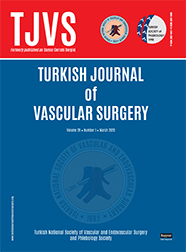
The Turkish Journal of Vascular Surgery
Yazarlar: Şahin İŞCAN, Özgür GÜRSU, Mustafa ETLİ
Konular:-
Anahtar Kelimeler:Renal insufficiency; arteriovenous fistula; hemodialysis
Özet: Objective: The need for arteriovenous fistulae (AVF) increases in line with the need for hemodialysis. Even though the first preference in advanced fistula operations is basilic vein transposition as recommended by Kidney Foundation, this approach has not been widely used in current practice because of difficulty of surgical intervention, and only major veins have been transposed using highly expensive mini- mally invasive techniques. In this study, our aim was to inquire applicability of basilic vein transposition in the current practice, and present early outcomes of a minimally invasive cost-effective surgical technique performed under local anesthesia. Material and Methods: In our clinics, between May 2012 and July 2013, three separate 1-2 cm incisions were made to expose basilic vein under local anesthesia, and the vein was trans- posed through the subcutaneous tunnel created medially. Preoperative access routes to dialysis, previous op- erations, preoperative and postoperative basilic vein diameters and fistula output and short-term follow-up results were evaluated retrospectively. Results: A total of 43 cases consisting of 25 (58.1%) males and 18 (41.9%) females scheduled for dialysis were included in the study because all forearm alternative vessels for fistula formation were used up before. Dialysis was done through preoperatively opened low-output AVF in 3, via transient catheters we inserted because of non-functional AVF in 26 and previously placed permanent catheters in 14 patients who had not undergone an AVF operation before. The mean operation time and hos- pital stay were 84.4 minutes (65-100 min) and 2.7 days (2-4 days), respectively. Mean preoperative basilic vein diameter was 3.5 mm (2.5-5 mm) while at postoperative 1st month, it was 5.4 mm (4-7 mm). Mean AVF out- put was 908.6 ml/min (500-1570 ml/min). Conclusion: Although basilic vein transposition ranks first among advanced fistula formation techniques, currently it is not used frequently. This technique can be performed through small incisions under local anesthesia and it can be employed as a low-cost procedure for creation of AVF using small-diameter basilic veins.
Dergi editörleri editör girişini kullanarak sisteme giriş yapabilirler. Editör girişi için tıklayınız.